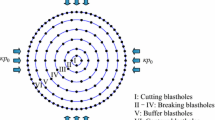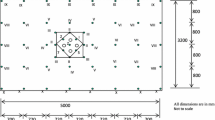Summary
Blast vibration and its attenuation within the rock mass immediately adjacent to a blast hole (2–15 m) were monitored for a blast hole diameter of 100 mm and a 2.4 m column of an emulsion explosive charge. Peak particle velocities calculated from the measured accelerations were compared with predictions from the charge-weight scaling law using typical site parameters which would be adopted for many far-field vibration predictions. It was found that the vibration amplitudes predicted by the conventional charge-weight scaling law are significantly lower than measured values. Strain and strain rates at different monitoring holes were calculated from experimental data. Using attenuation analysis of different frequency bands of measured acceleration signals, it was found that blast vibration attenuation between 2 m and 4 m depended not only on frequency but also on amplitude. A failure wave was postulated based on observations at the monitoring hole 2 m from the blast. A blast damage zone was evaluated using borehole camera and cross hole seismic studies. The damage zone in the rock was also analysed according to acceleration waveforms measured at different monitoring locations. The use of different techniques to measure blast damage provided an accurate assessment of the blast damage volume.
Similar content being viewed by others
References
Blair, D.P. (1990) Some problems associated with standard charge weight vibration scaling laws, Proceedings of the Third International Symposium on Rock Fragmention by Blasting, Brisbane, Australia, 26–31 August.
BlessS.J., BrarN.S., KanelG. and RosenbergZ. (1992) Failure wave in glass, Journal of the American Ceramics Society, 75, 1002–4.
DowdingC.H. (1985) Blast Vibration Monitoring and Control, Prentice-Hall, Englewood Cliffs, NJ.
Holmberg, R. and Persson, P.A. (1979) Design of tunnel perimeter blasthole patterns to prevent rock damage, IMM Proc. Tunnelling 1979, 12–16 March, London, 280–3.
KippM.E. and GradyD.E. (1979) The micromechanics of impact fracture of rock, International Journal of Rock Mechanics, Mining Science & Geomechanics, Abstr., 16, 293–302.
Langefors, V., Westerberg, H. and Kihlstrom, B. (1958) Ground vibrations in blasting, Waterpower, September.
TaylorL.M., ChenE.P. and KuszmaulJ.S. (1986) Microcrack induced damage accumulation in brittle rock under dynamic loading, Computer Methods in Applied Mechanics and Engineering, 55, 301–20.
Yang, R.L., Bawden, W.F., Talebi, S. and Rocque, P. (1993) An integrated technique for vibration monitoring adjacent to a blast hole, The Canadian Mining and Metallurgical Bulletin, 86 (972).
Yang, R.L., Bawden, W.F. and Katsabanis, P.D. (1994) A new constitutive model of blast damage, International Journal of Rock Mechanics, Mining Science & Geomechanics, Abstr. (submitted).
ZukasJ.A. (1982) Numerical simulation of impact phenomena, in Impact Dynamics, by Zukas J.A., Nicholas T., Greszczuk L. and Curran D., John Wiley & Sons, USA.
Author information
Authors and Affiliations
Rights and permissions
About this article
Cite this article
Yang, R.L., Rocque, P., Katsabanis, P. et al. Measurement and analysis of near-field blast vibration and damage. Geotech Geol Eng 12, 169–182 (1994). https://doi.org/10.1007/BF00426985
Received:
Accepted:
Issue Date:
DOI: https://doi.org/10.1007/BF00426985




